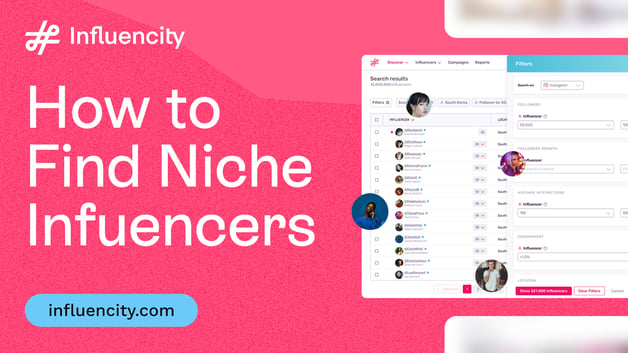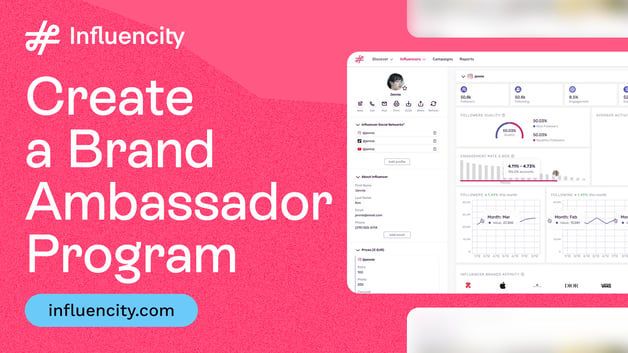Social Media
How to Use Social Media Tools for Influencer Performance Tracking
Social Media
I’ve seen a lot of influencer case studies that show results like reach and engagement. While these are both essential metrics to track performance, they don’t necessarily paint a complete picture. For example, there’s no telling if some of those engagements come from bots.
Many social media tools can give you access to these basic influencer metrics. But what you need is a tool that’s capable of doing a lot more than that.

In this guide, I explain some of the key influencer metrics that your tool should help you track. I also share how you can use powerful social media tools to track influencer performance.
Why Influencer Performance Tracking is Critical for ROI
Influencer performance tracking is a key step in ensuring that your campaigns are paying off. In fact, over 51% of influencer marketing experts agree that it’s the most critical metric for measuring influencer marketing ROI.
The process helps you figure out how to optimize your campaigns and improve their performance. For example, if certain influencers aren’t generating the desired results, you can exclude them from your campaign and focus on your most profitable influencers.

Similarly, you can see which influencer content is most impactful and amplify it for enhanced results. This could involve repurposing the influencer content for your brand’s ad campaigns, for instance.
Fortunately, there are many social media tools that can automate your influencer performance tracking. Instead of having to collect the influencer data manually from multiple accounts and social media platforms, these tools automate the process for you. So you can easily track all the important metrics in one place and even compare individual performance.
I love how tools like Influencity help you measure influencer impact before your campaign even launches. The platform uses predictive analytics to analyze influencer profiles and estimate their performance ahead of time. This streamlines your influencer selection process as you can easily identify which influencers will yield the highest returns.

Key Metrics to Track with Social Media Tools
With so many social media tools in the market, it’s easy to get overwhelmed. My advice? Know the metrics that matter and find the tools that can track all of them. This will streamline your search and help you narrow down the best option for you.
At the bare minimum, your social media tool should be able to track the following influencer metrics:
- Influencer Engagement Rate – This metric measures how actively engaged an influencer’s audience is. It compares how much engagement an influencer receives against how many followers they have. So instead of simply focusing on reach, you can look for influencers who can actually engage their audience.
- Conversion Rate – This metric measures how many followers took action, such as buying a product, signing up for something, or downloading an app. It’s a highly effective metric to understand if an influencer is capable of driving action.
- Social Media KPIs – Of course, you’ll want to track an influencer’s social media performance. This helps you figure out if their content is resonating with their audience. Look at metrics like reach, impressions, shares, and audience demographics.

- Fake Engagement – Most social media tools are capable of collecting engagement data and analyzing influencer engagement rates. Yet as I mentioned in the beginning, some of those engagements could come from bots. So you’ll want a tool that can effectively analyze the authenticity of an influencer’s engagement. This will help you spot influencers buying followers or using bots.
- Brand Sentiment Analysis – Engagements alone only give you half the picture. Even if people are authentically engaging with the influencer’s content, it doesn’t necessarily mean that those engagements are good. For instance, people may be commenting to complain about the product. So you need a tool that can analyze brand sentiment to help you understand how an influencer’s audience perceives your brand.

- Budget Tracking & ROI Measurement – Cost-related metrics are also essential to monitor if you want to stay within budget and see if influencer investments drive revenue. Look for a tool that can keep track of your spending and automatically calculate your campaign ROI. Personally, I’d also want to track metrics like CPE and CPM for each influencer and for the campaign as a whole.
Common Mistakes Brands Make in Influencer Tracking (And How to Fix Them)
Even with the best analysis tools, many brands still have trouble accounting for the business value of their influencer campaigns. I would chalk this down to the following influencer tracking mistakes.
Not Using UTM Links
For campaigns that involve things like sales, downloads, and signups, every brand realizes the importance of tracking conversions. But the mistake they make is assuming that it’s enough to simply see howat how conversions improve after the campaign.
Sure, they may see significantly more conversions after running an influencer campaign. They can also present this conversion improvement as a direct campaign result. At the end of the day, however, these “results” are still based on assumptions. Without UTM links, there’s no knowing how many of those conversions came directly from the campaign or how to attribute them to specific influencers.

In other words, not using UTM links or codes will lead to inaccurate conversion data. So it’s difficult to truly quantify the impact and business value of your influencer marketing efforts.
I highly recommend providing your influencers with UTM codes that they can include when sharing links to your website. This will make it easier to attribute traffic and conversions to specific influencer content.
So you can accurately track conversions resulting from your campaigns. Plus, you can see which influencers are delivering the most value and which types of content resonate with your audience.
Alternatively, you can also use audience discount codes that are unique to each influencer. This will also help you accurately track sales resulting from your influencer campaigns. You’ll also be able to see which influencers are driving the most sales so you can continue working with them for future campaigns.
Focusing Only on Vanity Metrics
I’ve seen my fair share of influencer marketing case studies where agencies only reported on how many likes and follows their campaign generated. While these metrics are relevant and often impressive, they don’t show you the actual business impact of your campaign. It’s always important to note that vanity metrics such as likes and followers don’t equal revenue.
-1.png?width=600&height=450&name=White%20%26%20Green%20Modern%20Bar%20Chart%20Graph%20(10)-1.png)
That’s not to say that you should avoid tracking these metrics altogether. Depending on your campaign goal, they still help you quantify success. What I mean to say is that your influencer performance tracking should go beyond these surface-level metrics.
In other words, you should also track metrics that closely contribute to actual business outcome. This would typically mean conversions, sales, and earned media value.

You should also be looking at metrics that will help you see if influencers are generating authentic engagement for your brand. This is crucial for brands that want to build a long-term connection with their audience and foster community. These engaged audiences become loyal customers and advocates who add value to the business.
Beyond engagement rate, look into the quality of those engagements. Are they helping you engage genuine followers? Are those engagements positive?
Ignoring Audience Sentiment
On a related note, some brands make the mistake of assuming that lots of engagements equal a successful campaign. While we all want our campaigns to drive plenty of engagement, we also need to dig deeper into those engagements. The same goes for brand mentions.
You never know if the thousands of comments are coming from people who want to complain about your brand or “call out” the influencer over some controversy.
So take the time to analyze the sentiment behind the attention that your brand is receiving. Fortunately, the Influencity platform comes with powerful sentiment tracking tools to understand how audiences feel about your brand. You can even dig deeper into the emotions behind your brand mentions and understand if people are feeling things like joy, anticipation, anger, or even disgust.

Using Multiple Tools Without Integration
Some brands want to track as many metrics as possible. So they turn to different tools to collect the data they need. While Google Analytics tracks their traffic, their ad platform shows them clicks and traffic generated from their ad campaigns. They may also use an influencer marketing platform to track additional metrics related to engagements, cost, and earned media value.

It's good to have all this data to get comprehensive insights into influencer performance. The trouble arises when these tools don’t integrate, which creates data silos and incomplete performance tracking. Not to mention how it’s highly inefficient to keep switching between multiple tools to manually collect the data.
I’d advise that you look for an influencer marketing platform that integrates with other key data sources. This goes beyond your social media accounts and includes your ad platforms and traffic data. Influencity lets you do just this by integrating the most important data sources so you can get comprehensive influencer performance tracking in one place.
How to Use Social Media Tools to Track Influencer Performance
Influencity is a leading social media platform that offers powerful tools for influencer performance tracking. Below, I break down the key steps to track influencer performance with Influencity as your main tool.
Estimate Influencer Performance to Streamline Influencer Selection
Most influencer performance analysis happens after a campaign has already been executed. Any analysis that happens before the campaign often focuses on an influencer’s audience size and existing engagement rate.
With Influencity, however, you can use AI-powered predictive analytics to estimate how your campaign and influencers might perform. The tool forecasts performance by calculating the influencer’s current performance along with the tasks assigned (e.g. number of posts they need to create).
You can add multiple accounts to your estimate. The tool then gives you an accurate idea of potential reach and spending based on that specific combination of influencers. So you can easily choose the best combination of influencers to work with and maximize your performance.

Integrate All Your Data Sources
To get a comprehensive look into your influencer performance, you need to collect data from multiple sources. This involves integrating all your social media accounts with your influencer marketing platform. So you can easily visualize how influencers are performing across different social media platforms.
Additionally, Influencity integrates with your ad platforms, including Google Ads and Facebook Ads. This plays a crucial role in monitoring performance if you choose to use paid ads to amplify influencer content.
That way, you don’t have to constantly switch between different platforms to get a comprehensive look into how influencers are performing across your campaigns.

Analyze Audience and Engagement Quality
With the ongoing issue related to social media influencer fraud, brands need to be wary of the audience and engagement quality of their influencers. Some fraudulent influencers may buy followers and hire bots for engagements. I’ve even seen influencers ramping up their numbers through engagement pods.
When this happens, it significantly limits your campaign outcome because you’re not reaching real customers. So it’s crucial to perform a fake follower check and analyze the quality of engagement an influencer receives.
Influencity’s follower quality metric makes it easy to quickly analyze an influencer’s following to see if their reach is manufactured. The technology uses natural language processing and image recognition technology to analyze an influencer’s profile and quickly determine how many of their followers are “doubtful.”

Further, even with real followers and real engagements, you may not always be able to tell if the engagements provide value to your business. Who knows? Most of the comments may even come from critics and disappointed customers.
So to get an even better understanding of engagement quality, use Influencity’s brand sentiment tracking features. This will analyze brand mentions to determine if they’re positive, neutral, or negative. It even goes so far as to analyze the emotions behind your brand mentions, helping you see if people are angry, fearful, happy, or sad when talking about your brand.

Track Individual Influencer Metrics Using UTM Links and Discount Codes
Sometimes, an influencer may look perfect on paper. But they may not have actual influence on the audience you want to reach. In some cases, they may be excellent influencers, but not well-aligned with your brand.
This is why I always recommend tracking individual influencer performance to get a better idea of which influencers are adding value to your brand. That way, you can tweak and fine-tune your campaigns to focus on your top-performing influencers. Otherwise, you risk spending money on influencers who don’t generate results. When you identify your best influencers, you can build long-term relationships with them and save time finding influencers for future campaigns.
Influencity collects the performance metrics of individual influencers across different social networks. This allows you to easily compare the reach, impressions, and engagements of different influencers.
You can also create audience discount codes unique to each influencer. Use these to accurately track conversions and sales that each influencer generates. So you can better attribute revenue and other business outcomes to specific influencers.

Monitor Influencer-Specific Spending
Most brands track their campaign spending as a whole. But cost-related metrics aren’t often tied into influencer performance tracking. Yet how much you’re spending on an influencer is a critical measure of their performance, as it all ties back to the ROI they generate.
Even if an influencer is generating significant engagement, their overall value may drop if it costs too much to drive those engagements. Alternatively, even if they’re charging more, the investment is worth it if they’re driving significantly better results compared to other influencers.
So I recommend that you closely monitor how much you’re paying each influencer and how this measures up against the rest of their performance. For instance, how much does each engagement cost with a certain influencer?
You’d ideally want to focus on influencers with lower CPE and CPM. That way, you’re spending significantly less considering the kind of reach and engagement they generate.
Influencity lets you monitor your overall campaign spending and influencer-specific costs so you can stick to your budget. It allows you to easily keep track of influencer payments and compare them against their performance to calculate metrics like CPE and CPM.

Track Influencer Performance Seamlessly with the Right Social Media Tools
As important as influencer performance tracking is for influencer marketing success, many brands still fall behind. This is largely because they fall victim to common mistakes and because they’re not using the right tools. Use the tips and strategies I shared above to make the most of Influencity’s performance tracking capabilities.
Jackie Zote
Jacqueline Zote is a freelance writer and content producer who specializes in putting together in-depth guides and articles on all things related to digital marketing. As a social media native who’s chronically online, she uses her expertise and experiences to tap into the pulse of social media and influencer...

























%20and%20How%20Can%20They%20Benefit%20Your%20Brand%20article.jpg?length=628&name=What%20Are%20Key%20Opinion%20Leaders%20(KOL)%20and%20How%20Can%20They%20Benefit%20Your%20Brand%20article.jpg)








